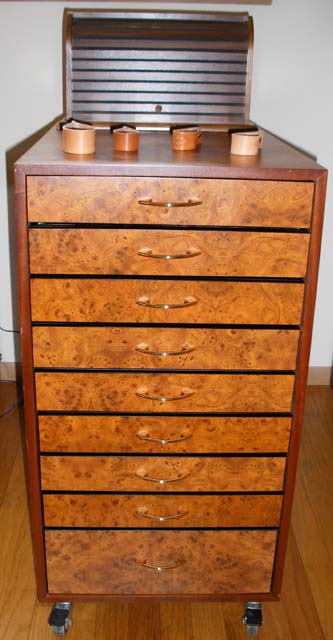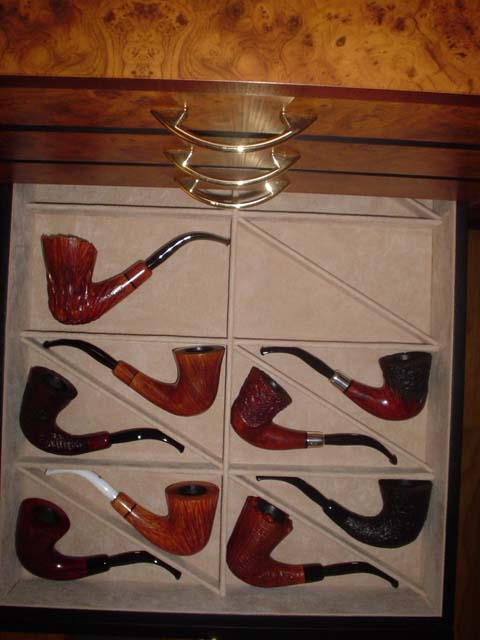A PIPE STORAGE SOLUTION Fred Heim |
|
After so many words about what goes into our briars, it seems time for an article about what our briars go into: pipe storage. While that hardly seems an earthshattering topic ("hasn't he heard of pipe racks," you're muttering), I've come up with a decidedly different storage solution that has proved excellent for me and my collection. In the possibility that it may help someone else, I'll explain the solution and how I arrived there. |
Twenty or so years ago, my pipe storage got started with a nice 6-pipe rack and grew willy-nilly from there. As my collection grew, I added racks: two-tier, three-tier, lazy susan, roll top. At one point, I purchased a beautiful Savinelli cabinet with glass doors. Soon there were racks or cabinets covering every flat surface in my small office. But there were problems. My calabash-shaped pipes were just not as easy to store as billiards or apples. Many are three-quarter or full bents, with wide tops and very narrow, pointed bottoms. The closed-hole lower levels of multi-tiered racks just couldn't accommodate many of my pipes. Even in racks built for larger pipes, with open 'U' tops and larger, wider eggs, my Castello 49s and many other calabashes flopped side to side, and even fell out on a few occasions. |
When I met fellow MAPS member and leather-smith Bob Schrap, I thought I'd found a solution. Bob makes great leather strap pipe rests. I started purchasing a number of them. Bob would even custom make them wider or taller to accommodate some of my more unusually shaped pipes, like the flying-saucer-shaped Bangs or the very tall, pointy Eltang. Soon the racks were less cluttered and my pipes more secure, but there were individual pipe stands all about the room. |
Now two other problems became apparent. First, though I tried to keep shades drawn and curtains closed during the bright hours of the day, I noticed my vulcanite stems going gray/green all too quickly. Cleaning the room was also a long chore, with dusty pipes everywhere. I needed to keep my pipes out of the dust and in the dark. |
I wasn't without suggestions. I consulted with Keen Bridgeman, who toyed with the idea of custom fitting the eggs in a traditional rack or cabinet to hold the pipes more securely. Jack Eisenhauer offered to craft a rack or cabinet that would hold the pipes by the tip of the stem, but I rejected this as too stressful on the stem over time. Rick Newcombe's idea of a picture-frame type cabinet with pipe clips and dark Plexiglas doors had distinct possibilities. But I have always been wary of the clips used to hold pipes by the shank. The rubber ones seem always seemed less than secure. The rubber-coated metal clips provide security, but I worried about wear to the shank over a long period of time. Finally, the lack of a large expanse of wall needed for so large a cabinet pushed me to continue searching. |
My mind kept coming back to something I had seen at Cristom's display at the Chicagoland show the first year it was held at Pheasant Run. Cristom's staff was packing up near the end of the show and placing pipes into the drawers of a beautiful burl-veneered cabinet. The drawers were lined with a suede-like material, subdivided into rectangles, with the rectangles subdivided on the diagonal to keep the pipes from contacting one another. It was the size of a three-drawer file cabinet and was on casters. When I inquired of the Cristom people, they discouraged me. These cabinets were really intended as shop fixtures, far too expensive for an individual collector and permanently out of stock. I put it out of mind until I found a large example of the cabinet at Tobacco World here in Milwaukee. But the owner was unwilling to sell what was part of his store display, and, though he tried to work with the Cristom folks, the larger cabinets were no longer available from the supplier in Italy. |
Success came when I was describing my dilemma to Rex Poggenpohl while chatting at a NASPC show. He knew exactly what I was describing because Iwan Ries had one in stock. I called Chuck Levi, who verified that he indeed had one. We negotiated a bit, and, after a quick run to Chicago, the cabinet was finally mine. The price was not insubstantial--think a very-high-grade Danish pipe. But it was a beautiful and well crafted piece of pipe furniture and a way to care for thousands of dollars worth of high-grade pipes in my collection. |
The cabinet has nine drawers, and each one can accommodate 20 pipes. The diagonal dividers are removable to accommodate a large pipe. Perhaps most important of all, the bottom drawer is double deep, to take the few very wide pipes in the collection that would not fit in the standard drawer. |
Now, I can hear the criticism coming. "That type of cabinet is meant for new, unsmoked pipes. A pipe that has been smoked has to be racked bowl-down in open air to properly dry. If Fred lays his pipes flat on their sides and closes them up in drawers, he will have the wettest, foulest collection on the planet." All serious concerns. Here is my solution. I have sold off most of my racks but retained a nice roll-top Savinelli that holds seven pipes and has holes in the back for ventilation. I have also saved the pipe rests that Bob Schrap made for me. When I finish smoking a pipe, if it has a Lucite stem, it goes in a pipe rest on top of the cabinet. If it has a vulcanite stem, it goes into the Decatur rack, away from the light. I try to do a thorough cleaning after four or five pipes, and the cleaned pipes go back in the rests and the roll-top rack to dry out for a week before going back into the drawer. |
So I have an approximately 100-pipe collection stored securely in the space of a small file cabinet, away from light and dust. I have provision to adequately dry pipes after smoking, and the cabinet is a beautiful piece of furniture in my home. I've taken the time to tell the tale, first, because I suspect there are others out there who have encountered similar problems and might not be aware of this potential solution and, second, to encourage the maker of these cabinets and our other fine pipe-furniture makers to consider making this storage solution available on a wider basis. |
Good smoking, and safe pipe storage to all. |
|
[An excellent article by Fred, and I hope that there might be some followup. I would hope that any of our members who are furniture makers, distributors, or whatever who are interested in pursuing this idea will communicate with Fred, who will report in a future issue about whether such a cabinet is available anywhere or if anyone is interested in building it to order. Fred's email address is fjheim3@sbcglobal.net. Ed.] |
|
|
|
|

